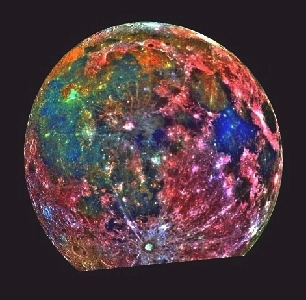
 The Moon Seen by the Galileo Spacecraft. Along its route to Jupiter, -it was to reach in 1995, the Galileo mission used two flybys at Earth and one at Venus. This view of the Moon was taken during the second flyby at Earth in December 1992. The craft was then at 262,000 miles (425,000 km) from our satellite. A false-color processing was used to produce this soil composition view. Main usual features of the Moon are well visible. Oceanus Procellarum, or Tycho -this crater at the center of a ray system- are easy to find. Lunar highlands are appearing red as mare -the lunar seas- are colored blue to orange. Bluer is indicating more titanium in the soils. Mare Tranquillitatis -the blue patch seen right- is clearly different from the Mare Serenitatis seen at its upper left. Orange and blue areas in the Oceanus Procellarum represent separate lava flows there. The southernmost part of the lunar disk is missing. picture courtesy JPL
The Moon Seen by the Galileo Spacecraft. Along its route to Jupiter, -it was to reach in 1995, the Galileo mission used two flybys at Earth and one at Venus. This view of the Moon was taken during the second flyby at Earth in December 1992. The craft was then at 262,000 miles (425,000 km) from our satellite. A false-color processing was used to produce this soil composition view. Main usual features of the Moon are well visible. Oceanus Procellarum, or Tycho -this crater at the center of a ray system- are easy to find. Lunar highlands are appearing red as mare -the lunar seas- are colored blue to orange. Bluer is indicating more titanium in the soils. Mare Tranquillitatis -the blue patch seen right- is clearly different from the Mare Serenitatis seen at its upper left. Orange and blue areas in the Oceanus Procellarum represent separate lava flows there. The southernmost part of the lunar disk is missing. picture courtesy JPL
Website Manager: G. Guichard, site 'Amateur Astronomy,' http://stars5.6te.net. Page Editor: G. Guichard. last edited: 12/28/2010. contact us at ggwebsites@outlook.com

